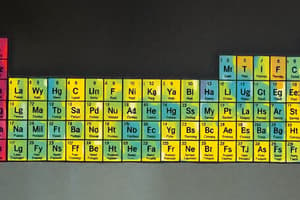Podcast
Questions and Answers
What generalization can be made about atomic size when moving from left to right across a period?
What generalization can be made about atomic size when moving from left to right across a period?
- Atomic size stays constant
- Atomic size increases
- Atomic size fluctuates randomly
- Atomic size decreases (correct)
Which trend is observed for ionization energy when moving from left to right across a period?
Which trend is observed for ionization energy when moving from left to right across a period?
- Ionization energy decreases
- Ionization energy increases (correct)
- Ionization energy fluctuates randomly
- Ionization energy remains constant
What property typically increases when moving from left to right across a period?
What property typically increases when moving from left to right across a period?
- Nonmetallic character
- Metallic character
- Atomic mass
- Electron affinity (correct)
What is the result of two atoms sharing electrons in a covalent bond?
What is the result of two atoms sharing electrons in a covalent bond?
Which theory explains the geometric arrangement of atoms in a molecule based on minimizing electron repulsion?
Which theory explains the geometric arrangement of atoms in a molecule based on minimizing electron repulsion?
What character typically increases going down a group in the periodic table?
What character typically increases going down a group in the periodic table?
What type of atoms form covalent bonds?
What type of atoms form covalent bonds?
What determines the overall strength of a covalent bond?
What determines the overall strength of a covalent bond?
What role do covalent bonds play in organic chemistry?
What role do covalent bonds play in organic chemistry?
Which theory explains the geometries of molecules based on repulsive forces among electron pairs?
Which theory explains the geometries of molecules based on repulsive forces among electron pairs?
What molecular geometry results in an angle of approximately 104 degrees, as seen in a water molecule?
What molecular geometry results in an angle of approximately 104 degrees, as seen in a water molecule?
How do electrons behave according to VSEPR theory?
How do electrons behave according to VSEPR theory?
Flashcards are hidden until you start studying
Study Notes
Periodic Properties and Chemical Bonding
In chemistry, understanding periodic properties and chemical bonding is crucial for explaining the behavior of elements in their natural state and how they combine with other atoms to form compounds. This knowledge has led to significant advancements in our ability to predict the characteristics of new materials and develop technologies based on these principles.
Periodic Trends
The periodic table, organized by atomic number, shows the progressive change in atomic properties when moving across a period (rows) or down a group (columns). Some generalizations can be made from observing these patterns:
- Atomic size increases going from left to right within a row.
- Ionization energy (the amount of energy needed to remove an electron from its atom) generally decreases going from left to right.
- Electron affinity (how much energy is absorbed or released when an electron is added to a neutral atom) typically increases going from left to right.
- Metallic character increases going down a column, while nonmetallic character increases going up a column.
These trends help chemists understand the reactivity of different elements and make predictions about which elements will behave similarly under certain conditions.
Covalent Bonding
A covalent bond forms when two atoms share electrons, resulting in stable arrangements known as molecular orbitals. This type of bonding occurs between non-metal atoms or between metal atoms that have similar ionization energies. The overall strength of a covalent bond depends on factors such as the difference in electronegativity between the atoms involved and the overlap of their atomic orbitals.
Covalent bonds play a major role in organic chemistry because they allow carbon to form chains and rings through sharing of valence shell electrons. These structures give rise to complex molecules like hydrocarbons, alcohols, acids, esters, amines, etc., all part of everyday life.
Molecular Geometry
The arrangement of atoms around a central atom in a molecule is called its geometric structure. In covalent bonds where there's no charge separation, the center of positive and negative charges coincides with the nucleus, leading to what's called central collision theory. This predicts geometries quite well except in cases where one electron pair is significantly more stable than another at some angle along a bond axis due to resonance effects.
Common types of molecular geometries include linear, trigonal planar, tetrahedral, square planar, octahedral, and pentagonal bipyramidal. Each shape corresponds to specific angles between bonded atoms and helps determine reactivities and stability of various chemical species.
Valence Shell Electron Pair Repulsion Theory (VSEPR)
This concept explains why molecules adopt particular shapes despite having multiple bonding pairs around a central atom; it involves repulsive forces among lone pairs and bonding pairs of electrons surrounding the central atom. The key idea here is that electrons want to minimize their interactions with each other, thus assuming positions on the surface of a hypothetical sphere drawn around a central atom.
For example, a water molecule consists of two hydrogen atoms and one oxygen atom, forming four bonding pairs (two O-H bonds and two H-O bonds). According to VSEPR theory, this results in a bent tetrahedral orientation with H-O-H being approximately 104 degrees apart.
Understanding chemical bonding and its associated trends, geometric arrangements, and VSEPR theory allows chemists to analyze structural features of molecules, predict their physical and chemical properties, and design novel materials tailored for specific applications.
Studying That Suits You
Use AI to generate personalized quizzes and flashcards to suit your learning preferences.




